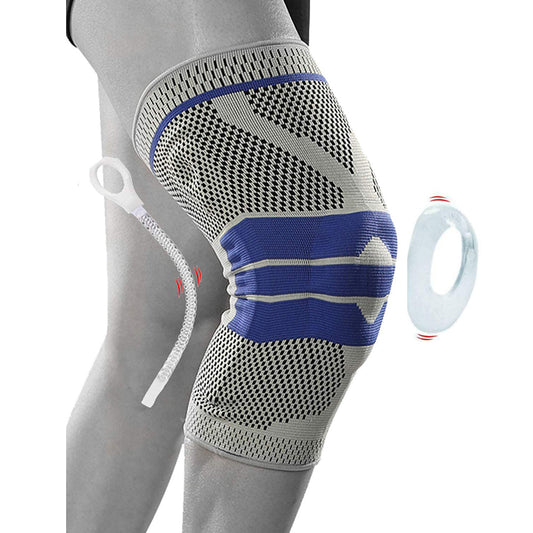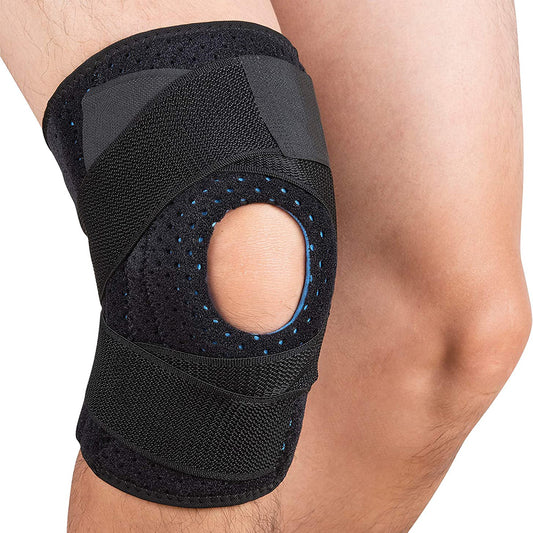-
Professional Knee Brace Compression Sleeve - Best Knee Braces for Men Women, Knee Support Protector for Running, Meniscus Tear, Arthritis, Joint Pain Relief, Sports Injury Recovery
Regular price $17.99 USDRegular price$27.99 USDSale price $17.99 USDSale -
Knee Braces with Spring Stabilizers & Gel Patella Pad for Knee Support – Adjustable Compression Wrap for Running, Arthritis, Meniscus, Tear for Men & Women
Regular price $25.00 USDRegular price$56.00 USDSale price $25.00 USDSale
Collection: Advanced Patella Gel Pad Knee Braces for Optimal Knee Support and Pain Relief
Introduction to Patella Gel Pad Knee Braces

As the leading innovator in knee support technology, ZSZBACE offers an unparalleled solution with our Advanced Patella Gel Pad Knee Braces. Engineered for superior knee protection and effective pain alleviation, these braces are a must-have for individuals seeking improved mobility and relief from conditions such as chondromalacia patella, arthritis, or sports injuries.
Why Choose Patella Gel Pad Knee Braces?
Who Needs This Product?
If you're experiencing knee pain due to daily activities, sports, or injuries, our knee braces are perfect for you. Whether you’re a runner, a housekeeper, an athlete, or someone who frequently kneels for work, these braces provide the necessary support to sustain an active lifestyle.
Characteristics of the Product
- Gel Pad Cushioning: Our braces feature gel pads that cushion the kneecap, providing both support and comfort.
- Spring Stabilizers: Enhance stability during movement based on the spring stabilizer inclusion.
- Adjustable Compression Wrap: Allows for custom fit tailored to your knee's shape and requirements.
- Superior Materials: Crafted from durable, breathable materials, ensuring longevity and comfort.
These features not only ensure the best fit but also facilitate faster recovery and pain relief, enhancing your overall physical performance.
Why Do You Need This Product?
Knee pain can be debilitating, affecting your quality of life and performance. The Knee Braces with Spring Stabilizers & Gel Patella Pad for Knee Support improve joint stability, alleviate discomfort, and protect you from further injuries. They are also crucial for managing chronic conditions like arthritis and aiding in the rehabilitation of meniscus tears.
Is This Product Suitable for You?
How To Tell If You Need This Product?
- Persistent Knee Pain: A sign that your joint may need additional support.
- Swelling or Tenderness: These braces help in managing inflammation effectively.
- Limited Mobility: If movements are restricted due to knee issues, these braces can ease the process.
If you're dealing with any of these symptoms, a knee brace might be a pivotal addition to your health regimen.
How the Patella Gel Pad Knee Brace Works
Correct Tracking and Stability
Our knee braces optimize joint alignment with patella tracking support, crucial for those suffering from misalignment-related pain. The compressive and stabilizing design ensures the kneecap remains central during movement, significantly enhancing stabilization and reducing strain.
Frequently Asked Questions
-
Can these braces be worn all day?
Yes, they're designed for comfortable prolonged wear, but it is advisable to remove them periodically for skin health and joint rest. -
Will they fit under clothing?
Absolutely, the sleek design ensures they fit comfortably under most clothing.
Enhanced Recovery and Performance
For those recovering post-surgery or intense physical activity, the Professional Knee Brace Compression Sleeve offers superior support, ensuring you safely navigate through recovery exercises and regain full motion range. This is essential for protection and prevention against re-injury.
Improve Key Physical Characteristics
The benefits of regular use of this knee brace extend beyond just pain relief:
- Strengthened Muscles: Participating in supported exercises encourages muscle development.
- Improved Joint Flexibility: Reduces stiffness, enhancing motion range.
- Better Circulation and Proprioception: Stimulated by the gel pad and spring stabilizers, promoting faster healing and greater body awareness.
For comprehensive knee support that combines advanced technology with exceptional comfort, look no further than ZSZBACE’s range of expertly crafted knee braces.
To explore our exceptional range and make a purchase, visit our product page for knee support for pain relief.
Discover the difference with ZSZBACE - where quality manufacturing meets innovative design for ultimate knee support and customer satisfaction.


